VVAM Newsletter 70 – 1998
FRIENDS OF THE AIRBORNE MUSEUM
Editors:
Drs. R.P.G.A. Voskuil
C. van Roekel
G.H. Maassen jr.
Newsletter No. 70, May 1998
Translated by Cathrien and Peter Clark
Representative in Great Britain: Mr. E.E. Shaw, 298 Totnes Road Paignton – Devon TQ4 7HD Tel. 0803-S53616
‘Liberators behind Barbed Wire’
Under the above title, the Airborne Museum’s annual theme-exhibition was opened on Friday 17 April last. The opening ceremony was conducted by Mr AJ.P. Beekmeijer who, as a Dutch commando, fought in the Battle of Arnhem in September 1944. Mr Beekmeijer was taken prisoner by the Germans on 20 September 1944 and was held in various prison camps in Germany until his freeing on 2 May 1945. The exhibition gives an overall picture of the fate of the prisoners-of-war from the 1st Airborne Division after the Battle of Arnhem. Of the approximately 10,000 British, Polish and Dutch who landed, more than 6,000 ended up in German prisoner-of-war camps. This figure included in excess of 2,000 wounded. Up until now very little attention has been given to the eight months that these POWs spent in German camps. Through tliis exhibition, which runs until 1 November 1998, the Airborne Museum wishes to throw the spotlight on this forgotten group. A ‘Prisoner-of-War’ newspaper containing text and photos about life in the camps has been specially produced for the occasion. Tliis unusual publication was sponsored by the ‘Arnhemse Courant’ and is limited to 15,000 Dutch and 3,000 English copies.
‘Teamwork’ led to interesting exhibition
The ‘Liberators behind Barbed Wire’ exhibition came into being thanks to the efforts of a great many people with the original idea coming from Roland Boekhorst, one of the museum’s conservators. Following an appeal in the Newsletter, an ‘exhibition’ work group was set up comprising Wybo Boersma, Frank Evers, Peter Stolte, Marcel Anker and Haks Walburgh Schmidt, all Friends’ Society members. In the past 6 months tliis group has gathered material, sifted through photographs, written text and compiled the POW newspaper. At the same time a building work group was formed, led by Roland Boekhorst and including Henk van de Brand, Jaap Jansen, Barry Tijssen and Theo Diepenbroek. This group has transformed part of the exhibition room into a camp barrack block, taking care that all work was technically and architecturally authentic.
Paul Geers, Aad Groeneweg and Hans Becher looked after all translations into English and German, and Jook van Slooten translated the POW newspaper into English.
Once again Willem de Ruyter produced the photo prints and the wallpainting was painted by Albert Zieck. Joop Bal and Berry de Reus put the video together after members of the ‘exhibition’ work group had given the required interviews.
Besides those mentioned above, dozens of other people and various museums co-operated by providing photographs, material, clothing, interviews, advice and so on. Visits were even made to the Imperial War Museum in London, the Airborne Forces Museum in Aidershot and the former POW camp in Fallingbostel in Germany as part of the preparatory work. General direction was in the hands of Wybo Boersma who also designed the layout of the exhibition.
(W. Boersma)

The bitilding work group of ‘Liberators behind Barbed Wire’: Theo Diepenbroek, Roland Boekhorst, Barry Tijssen, Jaap Jansen, Henk van de Brand, en Willem de Ruyter.
(photo: Berry de Reus)
Cycle tour
The previous Newsletter included an entry form for the cycle tour due to take place on 13 June. As indicated then, the theme for the day will be ’the 4th Parachute Brigade’. In the morning the sites visited will take in the landing zones at Wolfheze, the Ginkelse Heide and the Amsterdamseweg. Lunch will be taken at the West-End Motel. After lunch the tour will continue to the Leeren Doedel, the Airborne Cemetery and Oosterbeek Hoog railway station. From there we shall cycle via Johannahoeve to the small tunnel under the railway embankment, where another unusual part of the programme will be revealed. The tour will then carry on to ‘Hackett’s hollow’ alongside the Valkenburglaan. The tour will end at the Airborne Museum.
(Eugene Wijnhoud)
Newsletter copy deadlines
The editors regularly receive short articles from members for inclusion in the Newsletters. These mainly concern announcements about appeals or forthcoming books. This is a satisfactory development and we hope that members will continue to send in their bits and pieces.
Generally speaking the compilation, translation, correction, ‘cutting and pasting’, printing, addressing, packing and sending of the Newsletter requires a period of four to five weeks. The editors always try to ensure that the Newsletters drop on the members’ doormats in plenty of time for theme days or excursions, but due to the late arrival of copy or other delays they are not always successful. In order to minimise this problem it has been decided to introduce copy deadlines, i.e. final dates for the receipt of copy for inclusion in the subsequent Newsletter. These dates are as follows: 15 January: 15 March: 15 July: 15 September.
The general golden rule is: the sooner you get your copy in the better the chance of it being included in the next due Newsletter!
plan developments via the Newsletters.
New book for young people
A new book entitled ‘Krijt onder de Schoenen’ (Chalk beneath the Shoes) was published in February under the auspices of the Friends’ Society. It was written by our member Wim van Houten. He has managed to weave the experiences of his own family into an exciting story about the lot of a student from Leiden who is forced to flee to England at the start of the war. The story brings the (youthful) reader into contact with events and aspects of the Second World war in a readable and historically correct manner. Occupation, resistance, the ‘England voyagers and the training of Dutchmen and women in England, including parachutists and secret agents, are all covered, as are the war in North Africa, at sea, and the battle against German espionage in England. A large part of the book is given over to a description of the hostilities in and around Arnhem. Although written in the form of a story, the historical events are accurately and faithfully portrayed. Thanks to this it is without doubt a well-considered purchase. In view of the educational value that can be attributed to this book, the Airborne
Commemorations Foundation has decided to purchase 500 copies and to distribute them to school libraries in the region. We have also received a large order from PTT-Post (the Dutch telecommunications company and post office). Support from the Foundation for the Raising of Funds for Military War Victims, the Dutch Open Air Museum and the printers Tamminga Siegers has made it possible to offer the book at a price of 12 guilders 50 cents, bringing it well within the financial reach of 12 to 16 year-olds (and older).
The book was presented to the members during the society’s AGM on 4 April 1998.
Eventual interested parties (think of children and grandchildren) can purchase the book at the Airborne Museum.
(C. van Roekel)
Excursion to Normandy in 1999
Will there be an excursion to Normandy? This is the question often heard in recent times by the organisers of the excursions to England and Hamminkeln. The success of these trips abroad has shown that many members are not only interested in operation Market Garden, they would also like to know more about other wartime allied airborne operations. Management has therefore looked into the possibility of an affordable battlefield tour of Normandy.
Negotiations with a travel organisation have been positive and management has already begun the preliminary preparations.
An excursion is intended for May 1999. The next Newsletter will include an entry/booking form which you can use to put your name forward for a place on the tour. We shall keep you informed of
An ‘S-phone’in the Airborne Museum
Member Henk van de Brand was recently given a black case by his neighbour across the road who was about to move house. The case contained webbing carriers and a number of objects resembling radio parts. It was apparently dropped to the Resistance in 1944 and hidden in a shed by her father, a doctor where it remained unused for the rest of the war’ After the war the children played with it occasionally until it was once again forgotten, only recently reappearing in the face of the aforementioned house move. Further investigation proved it to be an ‘S- phone, type 13/Mark IV.
The S-phone is a transmitter-receiver with three functions. It can be used for radio-telephone traffic as a beacon for the guiding of aircraft (homing
beacon) and for the indication of dropping zones (parachute drop spot indicator). The Resistance used it m the last-mentioned mode. The equipment is powered by ten batteries, each in an individual carrier and fitted together in a larger webbing valise. The batteries were still in place in this example but unfortunately battery acid has badly damaged some of the carriers. Otherwise the whole unit is as new. S-phones were also used by the resistance in the Veluwe in addition to the well-known Eureka beacons. As far as we know there is only one other S- phone in the Netherlands, but this is in the hands of a collector and is no longer complete. An example of the special webbing valise for the battery carriers was recently discovered in England. It is hoped that one day an undamaged valise will be found for the unit that was given to Henk van de Brand. Meanwhile Henk has decided to give this unusual piece of equipment to the Airborne Museum on long¬term loan. There, after a thorough maintenance service, the S-phone will be put on show. (W. Boersma)

The ‘S-phone’ Hint the Airborne Museum recently obtained on permanent loan from Mr Henk van de Brand, (photo: W. Boersma)
South Staffords appeal
For many years Society members Alex Junier from Den Haag and Bart Smulders from De Zilk have been collecting information about the role of the 2nd Battalion The South Staffordshire Regiment during the Battle of Arnhem. Eventually, once their research is complete, they intend publishing a book on the subject.
Alex and Bart have already interviewed many veterans and would also like to get in contact with any civilians who, in those days in September 1944, were involved in the struggle in the areas of Arnhem and Oosterbeek where the South Staffs fought. This applies particularly to civilians living at the time of the battle in houses on the Utrechtseweg near the Municipal Museum in Arnhem and in the area around the Old Church in Oosterbeek. They are also looking for anyone who may know something of the events surrounding the death of Lance Sergeant John D. Baskeyfield at the Acacialaan on 20 September 1944.
Those willing to assist in this research into the South Staffords are kindly requested to get in touch with Alex Junier, Van Hogendorpstraat 76, 2515 NW, Den Haag, telephone 070 3893862.
Gift
Mr G.I. Schut from Wachtum recently presented the Airborne Museum ‘Hartenstein’ with a large box of original documents left by his parents. In 1944 the Schut family lived at no. 29 Cronjeweg, but during the fighting fled to no. 2 Annastraat, the home of Doctor Onderwater. The Voskuil family also sheltered here during the battle (see M. Middlebrook, pages 345 and 346). After the war Mr and Mrs Schut Sr. adopted the grave of Lt-Col Smyth, commander of the 10th Parachute Battalion in 1944, and kept in contact with his widow. They also kept contact with Major Peter Warr who commanded B company of the 10th battalion and was brought wounded to Dr Onderwater’s cellar along with the also wounded Colonel Smyth.
The collection contains correspondence, many ‘Hoog en Laag’ Memorial Editions, invitations and programmes for and of commemorations, Christmas cards from veterans and other items. The box also contained a damaged copy of a fairly rare booklet ‘Oosterbeek, geschonden en vernield; Het Nederlandsch Barbizon’ (Oosterbeek, damaged and destroyed; The Dutch Barbizon) by C. Koning, published in 1945.
We are extremely grateful to Mr Schut for his gift. The museum does not have the cemetery commemoration programmes for the following years: 1951-1954 inc., 1965,1969 and 1974. Who among our readers is prepared to offer these to the museum? Thanking you in anticipation.
(A. Groeneweg)
Tree carving protected
Society member Mr I.R.M. Goedings from Renkum has asked the Municipal College of Burgomaster and Aidermen if an inscription on a beech tree alongside the Hoofdlaan in Oosterbeek can be protected. The words carved into the tree are: ‘1st Airborne Div. Sept. ’44’.
We know for sure that the text was indeed carved in September 1944 thanks to information received from Mr Dolf van der Veen. On 18 September 1944 his 10 year-old brother Ruud was cycling through Oosterbeek. At the Hoofdlaan he saw a British soldier, after having dug his slit trench at the edge of a field, cutting the above text into the trunk of a tree with a black parachutist’s knife.
Fifty-four years after the Battle of Arnhem the inscription is still easily legible, and the council has assured Mr Goedings that the tree will be treated with the greatest of care. However, should it become necessary to fell the tree sometime in the future through old age or any other reason, the section of the trunk bearing the inscription will be saved and handed over to the Airborne Museum.

On IS September 1944 the then 10 year-old Ruud van der Veen watched a British soldier carve an inscription into the trunk of a beech tree along the Hoofdlaan in Oosterbeek. When this photo was taken in May 1997 the text was still easily legible. Both the tree and the witness have indeed become somewhat larger since 1944!
(photo: J. A. van der Veen)
Appeal
Following the excursion to the headquarters of the 1st Airlanding Brigade (Brigadier Hicks), organised by us in December 1995, we are now busy writing a booklet on the subject. In order to obtain as complete a picture as possible of the situation we are urgently seeking eye-witnesses who offered aid to wounded servicemen and civilians at the Tafelberg, Overzicht and Pietersberg in September 1944. We are also looking for people who sought refuge in the woods at Pietersberg and the Hemelsche Berg (including the area known as ‘de Hel’).
If you think you can help us would you kindly contact the Arnhem Battle Research Group, attention of Peter Vrolijk and Philip Reinders, Tripolihof 31, 3067 MZ, Rotterdam. We can be contacted by ‘phone after 7 pm on 010 4209992. Your assistance would be greatly appreciated (Peter Vrolijk & Philip Reinders)
Operation Market Garden computer game
Over the last fifty-odd years the Battle of Arnhem has become the subject of countless books, articles, documentaries and motion pictures. In more recent times a new medium has been added. Towards the end of last year the computer software giant Microsoft brought the computer game ‘Close Combat 2: A Bridge Too Far’ onto the market. It is not the first game based on the Battle of Arnhem, but it is by far the best!
In it the player commands a range of troops at platoon level, and one can choose the allied or German side. From the allied side, one has to attempt to capture the strategic locations around the bridges at Son, Veghel, Nijmegen, Oosterbeek and Arnhem, and establish a bridgehead over the Rhine. The more deeply the player becomes involved in the game the more apparent it becomes that this is anything but an easy assignment. The 1st British Airborne Division in particular is sorely tested. On top of this the game is in ‘real time’, so the possibilities for quietly contemplating the next tactical move just do not exist.
Microsoft have come up with a game of quality as far as picture, sound, ‘playability’, action content, accuracy, completeness and research are concerned. Minimum PC requirements are: Pentium 90 MHZ processor, 16 MB RAM, Windows 95, quad speed CD-rom drive, about 60 MB free disk space and mouse.
(R. Scheffers, Venlo)
Joe Roberts receives ‘Golden Award’
Member Joe Roberts was presented with a ‘Golden Award’ for his book ‘With Spanners Descending, A History of the Electrical and Mechanical Engineers with 1st Airborne Division: 1942-1945’ at a ceremony in London on 3 November 1997.
The ‘Help the Aged’ organisation awards this prize to people over 65 years of age who have made a worthwhile contribution to society. Joe’s award came in the category ‘Creative Work’.
The Friends’ Society would like to congratulate Joe Roberts on this well-deserved prize!
‘Roll of Honour’ to be reprinted
A reprint of the ‘Roll of Honour, Battle of Arnhem’ is currently being prepared. Additions already received since the previous issue are being included in the new text at the moment.
Any members who may have additions or corrections are kindly asked to get in touch with Mr J.A. Hey, Aad v.d. Leeuwstraat 12, 7552 HS Hengelo, tel. 074 2422271.
Correction
Alas, in Ministory number 57, ‘A Stirling at Planken Wambuis’, one of the names mentioned was partially incorrect. ‘Mrs Janet P. Wood’ should have read ‘Mrs Nancy P. Wood’.
Apologies from the editors.

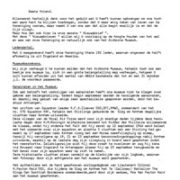
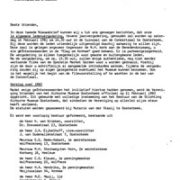
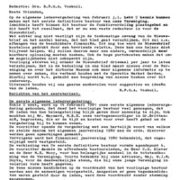
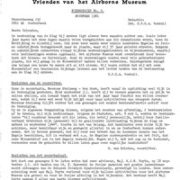
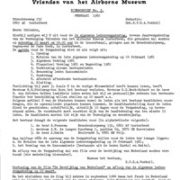
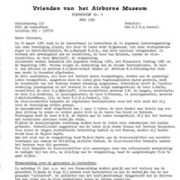
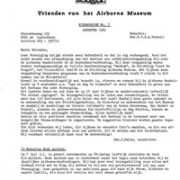
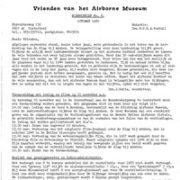
Plaats een Reactie
Vraag of reactie?Laat hier uw reactie achter.